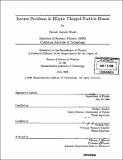| dc.contributor.advisor | Richard Temkin and Chiping Chen. | en_US |
| dc.contributor.author | Bhatt, Ronak Jayant | en_US |
| dc.contributor.other | Massachusetts Institute of Technology. Dept. of Physics. | en_US |
| dc.date.accessioned | 2007-04-03T17:06:41Z | |
| dc.date.available | 2007-04-03T17:06:41Z | |
| dc.date.copyright | 2006 | en_US |
| dc.date.issued | 2006 | en_US |
| dc.identifier.uri | http://hdl.handle.net/1721.1/37055 | |
| dc.description | Thesis (Ph. D.)--Massachusetts Institute of Technology, Dept. of Physics, 2006. | en_US |
| dc.description | Includes bibliographical references (p. [155]-159). | en_US |
| dc.description.abstract | The advantages of elliptic (or sheet) beams have been known for many years, but their inherent three-dimensional nature presents significant theoretical, design, and experimental challenges in the development of elliptic beam systems. The present work provides a framework for the design of elliptic cross-section charged-particle beam formation and transport systems. An effective mathematical formalism for describing accelerating elliptic cross-section beams is developed in which the particle distribution function for an elliptic beam is associated with a hyperellipsoid in phase space, and the evolution equations for the particle distribution hyperellipsoid are obtained. A novel methodology is presented for the design of elliptic beam-forming diodes utilizing an analytic prescription for the surfaces of three-dimensional electrodes which generate, accelerate, and confine a highly laminar elliptic beam. Three-dimensional simulations and tolerance studies are performed, confirming the theoretical predictions that a near-ideal beam can be produced. Focusing systems are described for elliptic beams in coasting, accelerating, and compressing regions with analytic prescriptions for the applied electric and magnetic fields required to maintain a laminar flow profile for particles within the beam. Numerical phase-space evolution and 3D simulations confirm that self-consistent laminar flow profiles are maintained by the theoretically-designed applied fields. The traditional approach to charged-particle dynamics problems involves extensive numerical optimization over the space of initial and boundary conditions in order to obtain desired charged-particle trajectories. The approach taken in the present work is to obtain analytic inverses wherever possible in order to minimize any necessary numerical optimization. Desired trajectories are assumed, and the applied fields and electrode geometries are then determined in a manner consistent with the assumed trajectories. | en_US |
| dc.description.statementofresponsibility | by Ronak Jayant Bhatt. | en_US |
| dc.format.extent | 159 p. | en_US |
| dc.language.iso | eng | en_US |
| dc.publisher | Massachusetts Institute of Technology | en_US |
| dc.rights | M.I.T. theses are protected by copyright. They may be viewed from this source for any purpose, but reproduction or distribution in any format is prohibited without written permission. See provided URL for inquiries about permission. | en_US |
| dc.rights.uri | http://dspace.mit.edu/handle/1721.1/7582 | |
| dc.subject | Physics. | en_US |
| dc.title | Inverse problems in elliptic charged-particle beams | en_US |
| dc.type | Thesis | en_US |
| dc.description.degree | Ph.D. | en_US |
| dc.contributor.department | Massachusetts Institute of Technology. Department of Physics | |
| dc.identifier.oclc | 81890774 | en_US |
